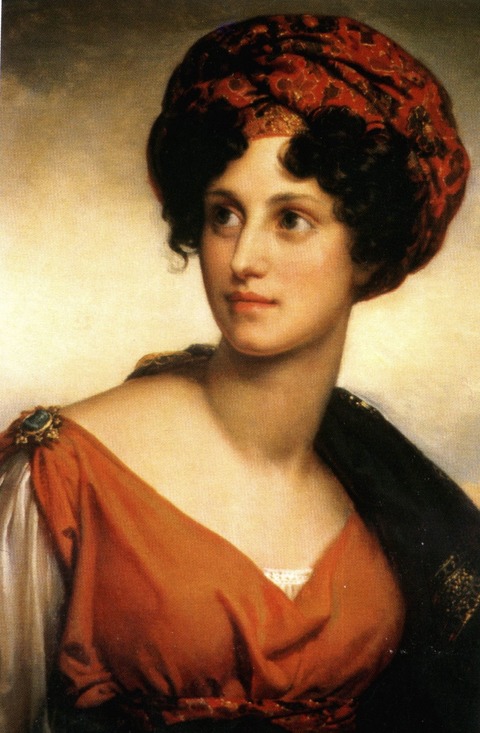Dorothea de Talleyrand-Périgord
(1793-1862)
At the time, no one could ever have suspected that the youngest of their four daughters would become one of the most influential women of the nineteenth century and a pearl of the European salons. Her father, the Duke of Courland and Semigallia, who enjoyed very close connections to the court of Stanisław August Poniatowski, ceded his duchy in Livonia and acquired the Duchy of Sagan. Following the division of Poland, the Sagan court became a refuge for royal musicians, sculptors and actors. It was in this artistic atmosphere that Dorothea grew up. She spent most of her childhood in Berlin, however, where the sons of King Frederick William III counted among her playmates. Dorothea's educator and teacher Scipione Piatolli undoubtedly had the greatest influence on her personality. Piatolli co-authored the Constitution of 3 May 1791 and served as librarian to the last Polish king. As a citizen of the world, he felt an allegiance to Poland. He imbued the young woman with a thorough knowledge of European culture and history, and moreover encouraged the budding love for Adam Czartoryski in the young woman's heart, seeing Dorothea's future husband in him. However, Dorothea's mother arranged with Charles Maurice de Talleyrand-Périgord for her to instead marry his nephew Edmond. The personal involvement of Tsar Alexander I also had a significant influence on the marriage. Dorothea obeyed her mother, wed at the age of 16 and left for France.
The marriage proved unhappy. Dorothea, the lady-in-waiting of Empress Marie Louise, was an intelligent, ambitious and well-educated young woman who enjoyed the recognition of her milieu. Edmond, for his part, was an officer in the Napoleonic army who recklessly devoted himself to the comforts of life. The stormy fate of this relationship, the constant parting and reconciliation ultimately ended in separation. Dorothea's talent for making friends, her independent way of thinking and her exceptional beauty were attributes that Edmond's uncle, Minister Maurice Talleyrand quickly noticed. He introduced Dorothea to the salons of Europe, where she rapidly garnered esteem and respect. Dorothea soon became Minister Talleyrand's closest friend and confidante, accompanying him to the Congress of Vienna, after which she remained at Maurice's side and managed the French embassy in London a few years later. She must have known all of the famous people of the time: Napoleon Bonaparte and Wellington, Metternich and Palmerson, Alexander I and Frederick Wilhelma IV, Louis-Philippe I and Camillo Benso di Cavour.
Dorothea was not only interested in politics though. Her inherited enthusiasm for art and culture led to friendships with many writers, composers and painters (R. Wagner, Delacroix, V. Hugo, H. Balzac, C. Rauch). She was able to find a common language with each of them. No one could resist her personable charm. In 1817 she gained the title of Duchess of Dino.
Following the death of Maurice Talleyrand, Dorothea became his sole heir, left France and settled in a small baroque castle in Günthersdorf (Zatonie) near Grünberg (Zielona Góra). This formed part of her inheritance. For her, the forests, meadows and free-ranging chickens clucking at her feet must have been very different for her from the castle hustle and bustle to which she had inextricably been linked for thirty years.
Dorothea turned her entire life upside down and reorganised it anew. She visited the surrounding parishes and schools and cared for the local population. In 1844, she received the fief patent for her residence in Sagan from the Prussian king and thus became the Duchess of Sagan.
The duchy flourished during the two decades of Dorothea's reign. The extensive conversion work in Günthersdorf and Sagan was accompanied by grand charitable gestures. The duchess employed the poorest locals to dig drainage ditches and flood dikes, offered them medical care and eventually had a hospital built for them in Sagan.
She had almshouses and schools built and endowed scholarships for gifted peasant children. She also consciously undertook measures of an ecumenical nature, having Catholic and Protestant children taught in the schools that she had built. She had a chapel built in the hospital for all confessions, too . In Silesia, where different cultures, religions and nations met, she was able to teach her subjects mutual respect through her actions. It is therefore perhaps unsurprising that her properties were spared from the revolutionary uprisings of 1848 that broke out throughout Europe. No one dared to attack the duchess who ruled in this liberal way. She probably also appreciated this gratitude of the commonfolk more than the atmosphere of the salons with all the flirtations and intrigues she had been accustomed to. Though the Duchess now devoted her life to this small place on the edge of Europe, she certainly did not forget Europe. Her friends always came to Günthersdorf and Sagan: the Prussian King Frederick William IV, Franz Liszt, Count F. Lichnowski, Alexander von Humboldt and Archbishop Dippenbrock.
When Dorothea passed away on 19 September 1862 following a serious illness due to a carriage accident while travelling from Günthersdorf to Sagan, her coffin was followed by the nobility as well as by the simple inhabitants of Sagan and peasants from villages all across the duchy. Tens of thousands of mourners bid farewell to their beloved duchess and accompanied her to the gates of the Church of the Holy Cross, which she had had rebuilt from its ruins a few years earlier.

